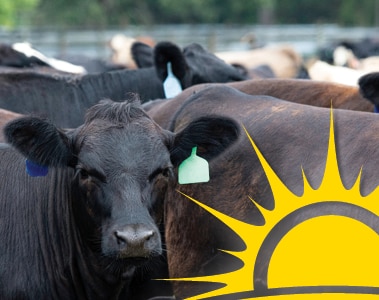Heat stress presents a significant challenge to the beef and dairy cattle industries, negatively affecting both animal welfare and productivity (Lacetera et al., 2019; Ríus et al., 2022). As temperatures rise, cattle are increasingly exposed to harmful conditions that can impair their health and performance. This problem is exacerbated when heat stress is combined with other stressors, such as mycotoxin exposure, leading to even greater negative impacts. This article explores the effects of heat stress, the role of mycotoxins, their combined effects, and potential mitigation strategies for sustainable livestock management.
Heat Stress in Cattle
Heat stress occurs when cattle are unable to effectively dissipate body heat, leading to elevated body temperatures and a range of physiological disruptions (Becker et al., 2020). This condition is particularly prevalent during the summer, with high daytime temperatures and inadequate nighttime cooling exacerbating the problem. According to Wickramasinghe et al. (2023), heat stress significantly elevates rectal and skin temperatures and increases respiration rates in cattle, indicating severe hyperthermia.
A relevant consequence of heat stress is reduced dry matter intake (DMI), as cattle instinctively consume less feed to minimize metabolic heat production (Collier et al., 2017; Al-Qaisi et al., 2020). This reduction in DMI can translate to decreased average daily gain (ADG) and overall poor growth performance. Furthermore, heat stress triggers physiological adjustments, such as increased peripheral blood flow, leading to hypoxia in the intestinal epithelium and subsequent oxidative stress and inflammation (Lambert et al., 2002; Lambert et al., 2004; Lian et al., 2021). Inflammation and the resulting immune system response have been demonstrated to redirect nutrients away from milk production in dairy cows (Baumgard et al., 2017).
Mycotoxins: Hidden Threats
Mycotoxins, toxic compounds produced by certain types of fungi, present another significant challenge in cattle management (Akande et al., 2006). Commonly found in contaminated feed, mycotoxins can cause a range of adverse effects, including immunosuppression, liver damage, and gastrointestinal disturbances (Yang et al., 2020). With chronic exposure, long-term health issues and decreased productivity can occur.
When combined with heat stress, the effects of mycotoxins can be amplified. Heat-stressed cattle already face compromised immune function and increased oxidative stress, which can exacerbate the detrimental effects of mycotoxins. This compounding stress can lead to a vicious cycle of declining health and productivity, underscoring the need for proactive management strategies.
Phytogenic Feed Additives: A Promising Solution
Phytogenic feed additives (PFAs) have emerged as a promising solution to mitigate the effects of both heat stress and mycotoxin exposure in livestock. Derived from plant-based bioactive compounds, PFAs are known for their antioxidant, anti-inflammatory, and immunomodulatory properties (Ramirez et al., 2021). These additives can alleviate oxidative stress and inflammation in heat-stressed cattle, improving their overall health and resilience (Wickramasinghe et al., 2023).
Research has demonstrated that PFAs significantly improve the average daily gain (ADG) in young calves (Schieder et al., 2014; Akbarian-Tefaghi et al., 2018) and in finishing steers (Brand et al., 2019). Additionally, it has effectively lowered blood lipopolysaccharide (LPS) levels in cows experiencing acidosis (Humer et al., 2018).
PFAs improve the intestinal barrier and reduce inflammation in stressed animals. A higher dosage of 150 mg/kg, compared to the standard 50 mg/kg, significantly increases body weight in feedlot cattle (Bachinger et al., 2019; Piran Filho et al., 2021).
Moreover, PFAs significantly reduce markers of inflammation and oxidative stress. Serum haptoglobin and plasma lipopolysaccharide-binding protein (LBP) concentrations were found to be 44% and 38% lower, respectively, in calves fed PFAs compared to controls. PFAs also reduced protein carbonyl and thiobarbituric acid reactive substances (TBARS) concentrations during the first day of heat stress, suggesting protection against acute oxidative damage (Wickramasinghe et al., 2023).
Compounding Stress: The Combined Impact of Heat and Mycotoxins
The interaction between heat stress and mycotoxin exposure presents a complex challenge for cattle producers. Both stressors independently impair immune function and promote oxidative stress, but their combined effects can be especially detrimental. Heat stress can enhance the absorption and toxicity of mycotoxins by compromising gut barrier function, while mycotoxins can exacerbate the physiological strain of heat stress.
Managing this compounding stress requires a multifaceted approach. Environmental management strategies, such as providing adequate shade, ventilation, and cooling systems, significantly mitigate the negative impacts on cattle. Additionally, incorporating dietary interventions like PFAs into cattle diets can enhance feed intake and protect against oxidative stress and inflammation (Chauhan et al., 2021). Regularly monitoring mycotoxin levels in feed and using mycotoxin binders when necessary is also crucial. Combining these dietary interventions with environmental modifications offers a holistic approach to managing heat stress and mycotoxin exposure.
Conclusion
Heat stress and mycotoxin exposure significantly challenge the beef and dairy cattle industries, negatively impacting cattle health and productivity. Phytogenic feed additives (PFAs) mitigate oxidative stress and inflammation, enhancing cattle resilience under stressful conditions. As the industry faces climate change and feed contamination, integrating PFAs with environmental modifications is crucial for sustainable livestock production. Producers can improve cattle welfare and performance by addressing heat stress and mycotoxin exposure, ensuring the industry's more resilient and productive future.


